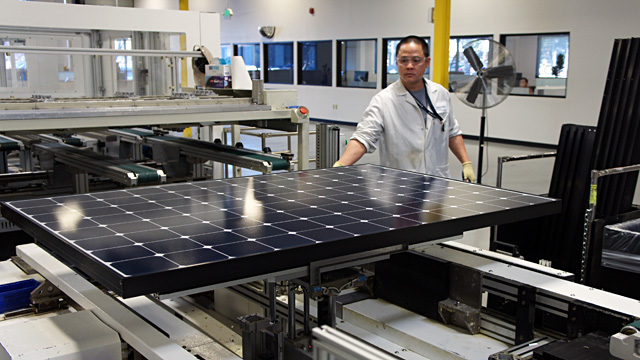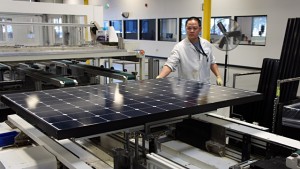Looming Trade War Shakes Up U.S. Solar Industry

Looming Trade War Shakes Up U.S. Solar Industry

Talk to anyone in the solar industry and they’ll tell you: it’s the best of times, it’s the worst of times. Solar installations are booming, but there’s also a looming trade war with China. Citing illegal subsidies, U.S. officials have placed trade tariffs on Chinese solar panels. American solar companies are split on whether it will be good or bad for the industry.
A Solar Manufacturer
At SunPower’s solar manufacturing plant near San Jose, workers screw frames onto shiny, six-foot solar panels as they come off the line. “We are running 24 hours a day,” says quality engineer Eric Kao.
This plant has had a long list of notable visitors: Governors Jerry Brown and Arnold Schwarzenegger, Energy Secretary Steven Chu. That’s because SunPower is one of the top suppliers in the country -- and because there aren’t many solar plants left to visit. It’s getting lonely to be an American solar manufacturer.
“It’s going to require being lonely to be one of the winners but it’s unfortunate that there aren’t many American solar companies,” says Tom Werner, CEO of SunPower. He says five years ago, things were looking good for U.S. solar manufacturers. There were growing markets in Germany, Japan and California.
“Many of the industry participants were making good profits. Well, that attracts competition,” he says. Chinese manufacturers flooded the market with solar panels. Within four years, panel prices fell seventy five percent.
“The economics have gotten way, way more challenging. It's difficult for some companies to make it,” Werner says. SunPower has survived, but is just hoping to break even this year.
Last year, several American solar panel companies filed a trade complaint against China, saying Chinese solar companies are getting illegal subsidies and are dumping panels on the US market. In May, the U.S. Commerce Department agreed and levied trade tariffs of 25 to 35 percent.
Werner says while SunPower didn’t directly join the complaint, it does stand to gain. “Let’s just say it won’t hurt our pricing but I don’t know if it will be a big advantage. Having a trade war is definitely not good for the industry so we need to sort this out.”
The solar industry doesn’t need more bad news, says Werner, especially after the political scandal over one particular bankrupt solar company. “It’s amazing how many people know the name of that company.”
Solyndra, that is. It’s a name Werner avoids saying, much like like Lord Voldemort in Harry Potter. “Well see, if I name the company then I’m just propagating the whole deal,” Werner says. Tariffs or no tariffs, Werner says some US manufacturers may not make it either. It’s an entirely different story with solar installers.
Flip Side: A Solar Installer
At Sungevity’s Oakland headquarters, a team of sales people grabs maracas off their desks. “So the maraca shake happens when there’s a sale,” says Danny Kennedy, president of Sungevity.
Sungevity is one part power company, one part internet startup. It designs residential solar systems virtually by using satellite photos of each house. Like online shopping, Sungevity makes a sale before a truck ever goes out. And sales have been good.
“We grew gangbusters in 2010. Doubled again in ‘11. Have continued to grow this year,” says Kennedy. That’s thanks to a new option for customers to lease a solar system, instead of buying it upfront. It’s also more affordable because panels are cheaper.
“This is something I think we should celebrate – the fact that we’re driving cost out of clean energy,” he says.
Sungevity buys panels from the US, Korea and from China. Even with the trade tariffs, prices are about the same because Chinese solar companies have found a loophole. The tariffs are only on solar cells, not the entire solar panel. So, the cells are manufactured offshore and put into panels in China.
But Kennedy says focusing on these manufacturing jobs is a mistake. The real green jobs are elsewhere. “There’s more job density in the sales, finance, installation and maintenance end of the value chain than there is in the factory. It’s probably a ratio of three to one.”
California leads the nation in solar jobs. Kennedy is concerned that a trade war with China would put them at risk.
“It’s crazy talk. We’re growing faster than any industry over a hundred billion dollars in value in the global economy. And yet, there is this nabobs of negativity around us that are causing concerns in the investment community,” says Kennedy.
Solar’s Teenage Years
All of this adds up to some major growing pains for the industry. “It is totally a teenager in a lot of ways,” says Dan Kammen, a professor at UC Berkeley.
“The industry is growing dramatically. There’s also incredible turmoil. And there are some teenagers who are clearly going to be young prodigies and others who are going to go into rehab,” says Kammen.
When companies fight over market share and race to the lowest price, Kammen says it’s the startups with cutting-edge technology that just can’t compete.
“A battle between the two biggest players, the US and China, is one where we might actually have casualties that aren’t just business casualties, they’re actually, pieces of innovation getting lost.”
The trade tariffs won’t be final until the US International Trade Commission rules on whether China has been illegally subsidizing their solar industry. That decision is expected on Wednesday.
